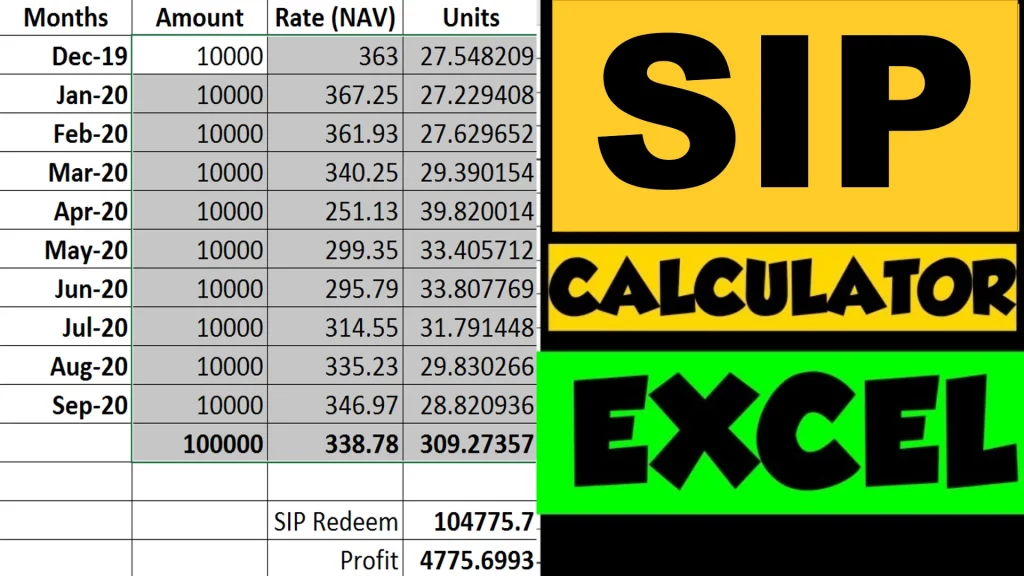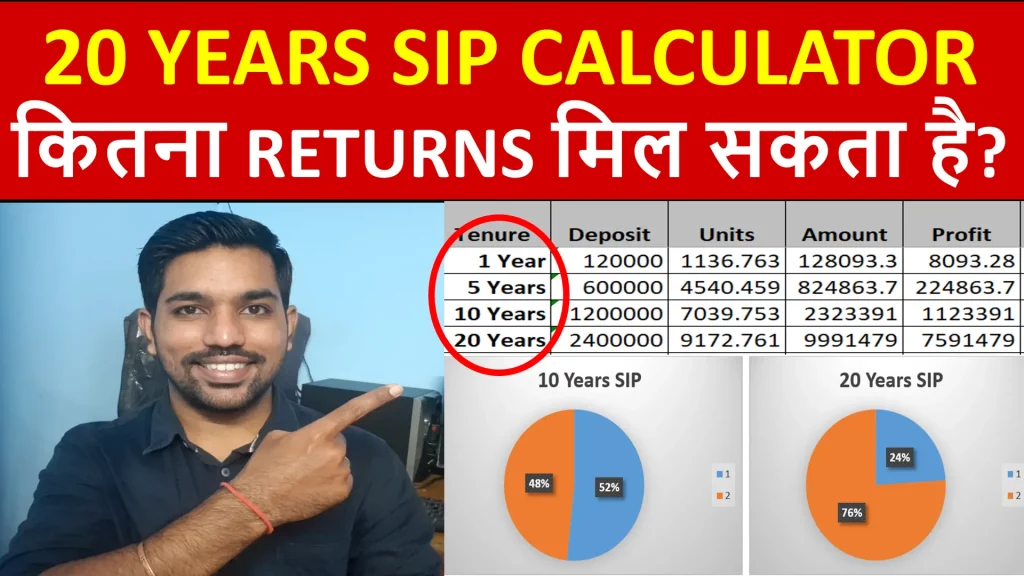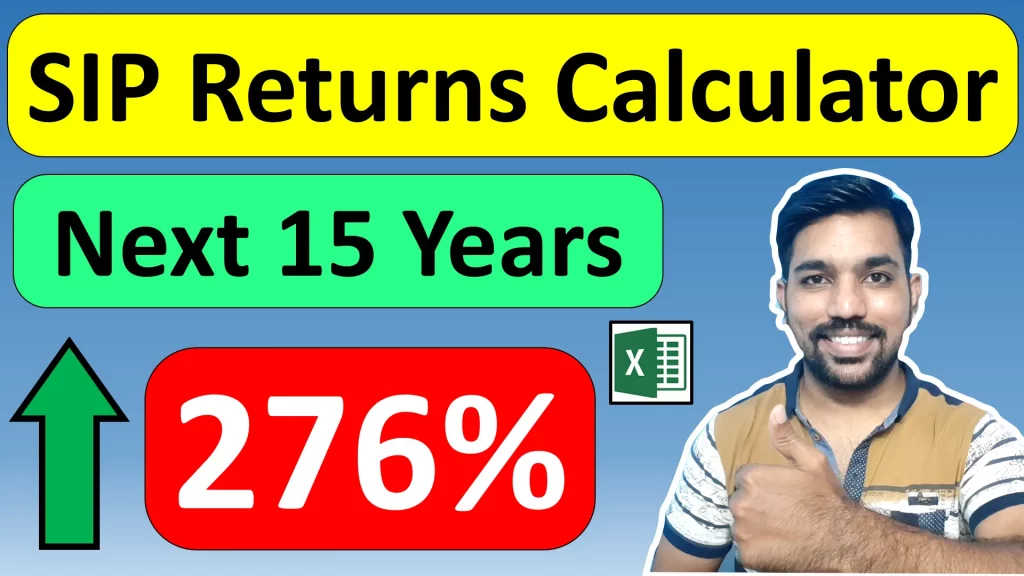Many people ask on my YouTube Videos comments that how is SIP return calculated, which SIP is best for 15 years, what is the average return on SIP or what is a good SIP return and is there any SIP return calculator available in Excel?
SIP or Systematic Investment Plan in mutual funds help us to achieve our goals in a systematic and disciplined manner. One can use the SIP Return Calculator in excel which is the offline method to calculate SIP Returns. This article also contains information about your SIP returns for next 5, 10 or 20 years while you just provide your SIP amount and the expected returns, all of which can be done using an Excel Calculator!
SIP Return Calculator Video using Excel


What is SIP
SIP or Systematic Investment Plan is a way to invest in Stocks or Mutual Funds periodically, over a period of time. You can choose to invest every month or every week. Full form of SIP is Systematic Investment Plan.
SIP is the best way to invest in Stocks or Mutual Funds compared to the Lump sum investment, in which, you invest the entire corpus in one go. Whereas, in SIP you are disciplined enough and invest a fraction of your corpus every month or week. There are many Benefits of investing via SIP route compared to Lump sum investment.
Love Reading Books? Here are some of the Best Books you can Read: (WITH LINKS)
Benefits of SIP
- Allows you to invest only a fraction of amount instead of entire corpus in one go. You can choose this fraction of amount as SIP based on your affordability
- You can have multiple SIPs based on your goals whether they are short term, medium term or long term goals
- SIPs are flexible these days. You can choose to pause a SIP for few weeks or months, or stop SIP if your goal is achieved before time
- You become disciplined in working towards goals with given timelines
Rs. 2000 SIP Returns Calculation

Watch more Videos on YouTube Channel
How Returns are calculated in SIP
You must have heard about NAV (Net Asset Value) of a Stock or Mutual Fund.
If not, NAV or Net Asset Value is the price of a unit of Stock or Mutual Fund. That means, it is the value of per share or a unit in Stock or Mutual Fund.
Example
Let’s say NAV of a Mutual Fund is Rs. 100.
This means the price of 1 unit of this Mutual Fund is Rs. 100.
If you invest Rs. 100 in this Mutual Fund, you get 1 Unit of this Mutual Fund in your Investment Account.
If you invest Rs. 1000, you get 10 Units.
If you invest Rs. 10,000, you get 100 Units and so on.
In this way you accumulate Stocks or Mutual Funds Units in your Investment Account.
20 Years SIP Return Calculator Video

Formula
Units = Amount divided by NAV
In similar way, in SIP, you invest every month, and you accumulate Units based on the NAV of Stocks or Mutual Funds on that Day.
Here are some Screenshots of Units Accumulated over period of time:

Rate of Return = 10%
Total Units Accumulated = 10,448.82 over a period of 20 Years

Rate of Return = 12%
Total Units Accumulated = 9172.761 over a period of 20 Years

Rate of Return = 15%
Total Units Accumulated = 7689.156 over a period of 20 Years
As seen above, with increase in expected Rate of Return, the NAV increases and the total units you can accumulate decreases. Total Units accumulation are inversely proportional to NAV.
SIP Return Calculator for Next 10 Years Video

How you can maximize SIP Returns
One cannot time the market to take the advantage of ups and downs.
Theoretically, it is seen that you should buy low and sell high in order to get maximum returns, but can you predict those ups and downs in market? You cannot.
If it was easy to time the market, people would be busy making money in markets instead of explaining you how to make money online or how SIP works!
History has taught us that the dead (or inactive) accounts who don’t panic buy or panic sell based on their emotions related to market ups and downs have got the advantage over active accounts.
People with active accounts try to be smart and time the market. But they lose in long run.
Only 0.1% people would be able to time the market only 0.1% times based on their luck.
- So the best way to get maximum profit is to continue with SIP over longer run
- Don’t panic buy or panic sell based on emotions
- Don’t try to time the market
- Start investing and forget about it
- Invest in low cost Funds
How to choose from several Mutual Funds
Every Mutual Fund has Expense Ratio related to it. This is the fees that AMC (Asset Management Company) takes in order to manage your funds.
You should choose the Mutual Fund that has low Expense Ratio.
Low expense Ratio means you have to pay low fees on your Assets under Management.
Speaking of Low expense Ratio, Index Funds are the type of Mutual Funds having Low Expense Ratio, thus Low fees.
So the secret to maximize your returns in Mutual Funds is to start SIP in low fees funds, such as Index Funds, and to start investing and forget about it until you reach 60 or more.
DOWNLOAD SIP RETURNS EXCEL CALCULATOR
Click below button to Download SIP Return Calculator in Excel:
Some more Reading:
Frequently Asked Questions (FAQ)
What is the Full Form of SIP?
SIP full form if Systematic Investment Plan. Usually SIP is a specific amount you invest every month to achieve specific goals with specific tenure (time period)
How SIP works?
SIP is the specific amount you invest every month for a specific goal with a specific period of time. You invest an amount of let’s say Rs. 5000 every month for 5 years and with expected returns of 10% per year. In this case, after 5 years your expected investment value would be Rs. 3,90,411 according to the SIP returns excel calculator provided above. This makes you a profit of Rs. 90,411 in 5 years and also helps you achieve your goal.
What is lump sum investing?
Lump sum investing means you invest entire amount in one go. Let’s say you have Rs. 1,20,000 to be invested for a year. In SIP, you divide this Rs. 1,20,000 for 12 months (1 year) and invest Rs. 10,000 every year in a mutual fund. On other hand, in lump sum investing, you invest entire amount of Rs. 1,20,000 in first month in one go. This is called lump sum investing.
What is better SIP or Lump sum investing?
Combination of both SIP and Lump sum is better. You can continue with your SIP during normal days and invest lump sum amount if available when market goes down. This way you get more units when market is down and make more profits during market crash.
Save Home Loan Interest Amount!
Use Home Loan Excel Calculator that will help you to Save Interest Amount on Home Loan EMI.
Click below button to download Home Loan EMI and Prepayment Calculator in Excel:
Watch how Home Loan Calculator in Excel Works
Income Tax Calculator App – FinCalC
For Income Tax Calculation on your mobile device, you can Download my Android App “FinCalC” which I have developed for you to make your income tax calculation easy.
What you can do with this mobile App?
- Calculate Income Tax for new FY 2024-25 and previous FY 2023-24
- Enter estimated Investments to check income tax with Old and New Tax Regime
- Save income tax details and track regularly
- Know how much to invest more to save income tax
- More calculators including PPF, SIP returns, Savings account interest and lot more

Use Popular Calculators:
- Income Tax Calculator
- Home Loan EMI Calculator
- SIP Calculator
- PPF Calculator
- HRA Calculator
- Step up SIP Calculator
- Savings Account Interest Calculator
- Lump sum Calculator
- FD Calculator
- RD Calculator
- Car Loan EMI Calculator
- Bike Loan EMI Calculator
- Sukanya Samriddhi Calculator
- Provident Fund Calculator
- Senior Citizen Savings Calculator
- NSC Calculator
- Monthly Income Scheme Calculator
- Mahila Samman Savings Calculator
- Systematic Withdrawal Calculator
- CAGR Calculator
I’d love to hear from you if you have any queries about Personal Finance and Money Management.
JOIN Telegram Group and stay updated with latest Personal Finance News and Topics.
Download our Free Android App – FinCalC to Calculate Income Tax and Interest on various small Saving Schemes in India including PPF, NSC, SIP and lot more.
Follow the Blog and Subscribe to YouTube Channel to stay updated about Personal Finance and Money Management topics.









